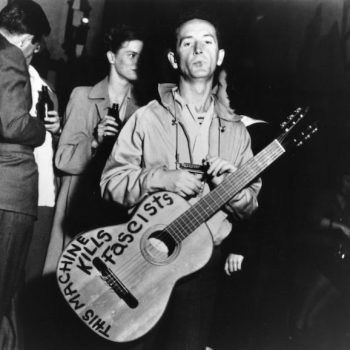 I had to read this book again last week for a class. It was great to cover the material again. I’ve got tons of notes from studying this over the past couple of years. I decided it was time to post a review:
I had to read this book again last week for a class. It was great to cover the material again. I’ve got tons of notes from studying this over the past couple of years. I decided it was time to post a review:
Book Review: Missional Church – Darrel Guder ed.
Reading these six authors who contributed to Missional Church has been a fruitful approach to studying ecclesiology. Guder introduces the project and writers in the first chapter, stipulating that this consortium believes the church must make a change in self-perception. It must cease to see mission as a program of the church and begin to see it as the defining characteristic of the church. The movement is from “church with a mission to a Missional church.”[1]
Craig Van Gelder draws the assignment of describing first, the culture of North American and second, the status of the church in North America. He begins by sketching the hurried and complex “modern self.”[2] This “modern self” has several distinguishing characteristics which affect the role of the church within a society of rights and freedoms. This includes nationalism and the concept of the individual trading allegiance to country for rights and freedoms. Describing the modern self as pushed to consume whether or not it is necessary he exposes the way the worth of the individual in this system is tied to their function as faithful producers and consumers and how status is a reward for their faithfulness at production and consumption.
Perhaps the more innovative section in this chapter was on the idea of the modern self as a product of technique. In a society where new is always better, efficiency is more desirable, and there is a technique which will solve every problem the modern self will relentlessly pursue and perfect techniques which will advance that agenda. Church is no exception to this approach.
Van Gelder transitions to the postmodern condition by describing several key factors: relative truth, the de-centered self, and a pervasively pluralist society; all of which characterize the postmodern reality.[3] The new, open perspectives concerning truth, the collapse of confidence in radical individualism, and the rejection of any privileged position for a certain religious sect within North American culture confirm that the entire social order is changing. The context of the church has shifted and the current task of the church is to address these new realities.
George Hunsberger takes over for Chapter Four, which I think is the finest chapter in the book. He begins by saying the church described in Chapters Two and Three will necessitate wholesale change – not simply “tinkering.”[4] He traces the way that the reformation and enlightenment framed ecclesiology. The reformers described the church as “a place where certain things happen.”[5] The church as place concept allowed the church to become “a vendor of religious services and goods,”[6] forced churches to compete with each other for market share.
The enlightenment ushered in the supremacy of rationalism and faith became a rational thing. As a result of the basic enlightenment tenet of personal freedom, the only option for society was to embrace religious pluralism. Thus religion essentially became a rational and private affair.
Hunsberger then begins to expound on the kingdom of God. He flies through dozens of New Testament verses concerning the kingdom, how one might discern it and interact with it. The shift this theology demands of the church is that she should now see herself as part of the mission of God which is the reign of God. His prescriptive section recommends three courses of action: 1) Being: the church must first embody the kingdom of God, 2) Doing: the church must fight the urge to let our “doing” be enforcing a moral agenda, but rather let our doing be an active of self-sacrificial service to the culture, and 3) Speaking: the voice of the kingdom must be that it is free to all who would embrace it.
The beauty of this chapter is the way that the prescription so nicely ties to the diagnosis of the problem. These three actions of the church, if done faithfully, could potentially counteract the view of the church as a vendor of religious services by conceiving of the church not as a place but a people called to a mission. It can counteract the view of the church as privatized by engaging the world at its point of greatest need, i.e., actions of mercy and social justice toward the poor & oppressed. Finally it can counteract the pluralistic notions by speaking boldly the message of hope.
Chapter Five espouses a legitimate political role for the church. The author of this section Lois Barrett says that mission must be centered in worship and cannot become wedded to culture. She argues for a non-violent approach to any political involvement.
Chapter Six explores the formative element of the Holy Spirit in the life of the church. Here eschatology plays a major role. Ingrace Diettrich writes this section and urges the reader to see God’s future breaking into the present reality. The approach to culture, says Diettrich, must never fully accommodate it or even to attempt to transform it as a whole. She espouses a counter-cultural approach for the church, living as full participants in the culture but in distinctive ways. In terms of ecclesial practices she points out that the churches practices are historical, communal, experiential, and dynamic. Missional communities will be varied and rich but should include rich expressions of sacrament through baptism, Eucharist, reconciliation, discernment, and hospitality.
Chapter Seven delves into the leadership practices necessary in a missional church. This will involve embracing the role of leadership as priest, pedagogue and professional.[7] Alan Roxburgh, who writes this section, emphasizes that leadership practices are not morally neutral. It is possible and even likely that failure in this area will result in falling back into consumeristic impulses and meeting felt needs of congregations. It will also result in treating the faithful members as a sort of “work force” to meet the needs of the consuming body.[8]
The final two chapters consider the structures which are needed both in the context of the individual church and the church at large. Not surprisingly Guder argues that structures must serve the missio Dei, not the church. Principles which govern the particular churches should be tied to scripture, diversity, and community. Likewise the structure of the universal church must serve the mission as well. He emphasizes the marks of the church: apostolicity, catholicity, holiness, and unity. He urges more connectedness and unity of mission which will protect diversity.
I really have little to criticize about this book. The entire work is loaded with research and theologically provocative ideas. They are all solid writers and I really don’t find any holes in what they are trying to say. I will say that I think George Hunsberger was the best writer of the bunch and that his two chapters were the high-water mark. A church of being, doing, and speaking in exactly the fashion he describes would seem to me an amazing thing in our world today. This church could serve as a corrective to the distortions resulting from the reformation and enlightenment. My most significant learning from this book came from these two chapters and I think they will serve to further the conversation in my own community concerning the nature of the church.
Roxburgh’s chapter on Leadership has been challenging for me as well. The idea that leadership is never morally neutral will haunt me for years to come. I’ve been very convicted by the idea that we end up treating devoted disciples as “volunteers” who then are used to meet the needs of the throngs of consumers who come to our churches to be “fed.” I know some may see this as a cynical picture, but I think it is incredibly accurate.
If I were forced to critique a section it would be the structures sections in the last two chapters. This is the only part that seems a little naïve especially their ideas on membership and the possibility of normative structures for Missional churches. It’s just so complicated and so few churches are actually doing this that the structure conversation just seems like a puppet show right now. I’m also not ready to give up on the idea of Parish just yet. I still think there might be a parish approach that would be fruitful, especially in urban areas. But those are nit-picking critiques.
Taken as a whole this book was fantastic and my guess is that it will serve to feed my imagination for years to come. As an aside, my church has already begun to blog and talk about these ideas and we’ve had one message on Guder this month. The book is already spurring good dialogue considering the nature mission of the church.
[1] Missional Church p.6.
[2] Ibid. p.19-20.
[3] Ibid. p. 37-43.
[4] Ibid. p. 77.
[5] Ibid. p. 79.
[6] Ibid. p. 84.
[7] Ibid. p.190
[8] Ibid. 202-213.
Since I originally wrote this paper, I’ve developed a few other critiques:
- I heard Roxburgh (one of the authors) once as he talked about when they were writing the Guder book on Missional Church. They sat with Hauerwas, someone else and Justo Gonzales. Justo’s group was saying that “this conversation you are having is your conversation.” It’s not our conversation. It’s a conversation among white people who have felt that they are starting to lose the hegemony. This book never gets written unless the white protestants are losing their hegemony. Which means that the book is in part a way for the white men to regain their hegemony. I think that taints the entire work to some extent.
- Mission is currently being co-opted as a Strategy: My question is, do we really engage this entire endeavor as means of transforming our churches, or as a means of transforming the world? Because if it is God’s mission, I think we simply do this in response to who God is, not merely to make a difference. I don’t know any other way to conceive of it that doesn’t become contingent upon results. Success in salvation is contingent upon God, success of the church has been contingent upon us. That’s a problem. If all we do is try and deploy missional language and strategy as a way to retain power and grow our churches, we’re really missing the point.
- A pre-9.11 analysis of North American culture doesn’t quite seem complete anymore. It leaves too many holes. There seems to be a groundswell of support for a church engaged in the mission of the world’s lone superpower to care for the world’s poor.
- Weak use of narrative: I applaud the effort to try and use narrative but their stories are amalgamated and contrived and almost seem cliché. I don’t think that added to the book’s effectiveness. They seemed like thoroughly modern thinkers pretending to be conversant with the emerging church. I could be wrong about that, I know most people have a tremendous amount of respect for Guder, as do I. But the narrative came off as weak and contrived.
- P. 48 I don’t know if I buy the idea of functional Christendom. I think we live in a post-christendom world and I don’t think the whole concept of christiendom was really a good idea to begin with.
- I think that Social Gospel theology can work (59) in a post-liberal sense (removed from the pitfalls of liberalism and the critique of Feuerbach). Once the “will to power” has been subverted, the tenets of the social gospel can become kenotic. Once the individualism is subverted, the “common good” is back in the game. The social gospel will come back in the post-modern era & be a much more workable option.












